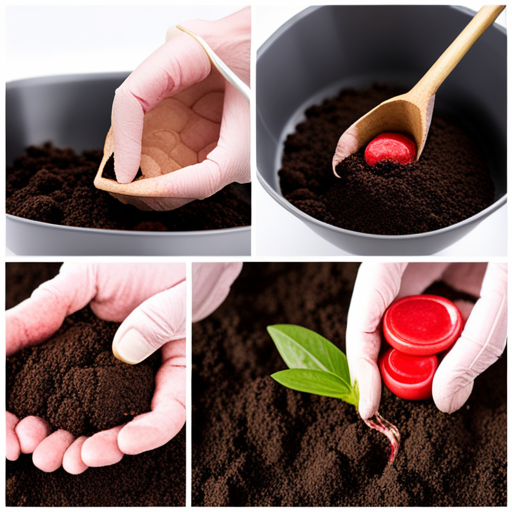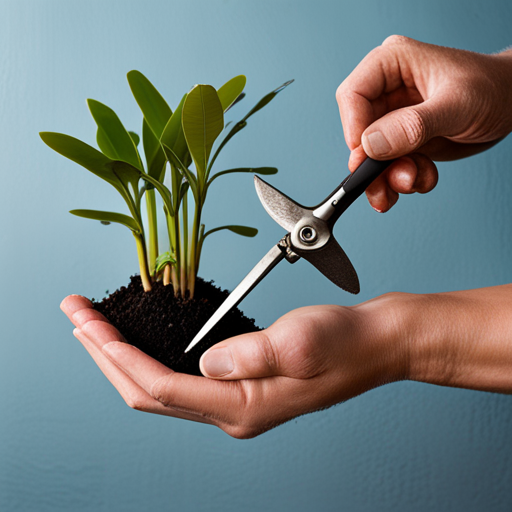Red button ginger, also known as Indian Head Ginger or Scarlet Spiral Flag, is a tropical plant with striking features that make it a popular choice for gardens and landscapes.
This article provides comprehensive guidance on how to successfully grow and care for red button ginger. It begins with planting and growth tips, highlighting the ideal time for planting and the plant’s growth rate and height.
The article then discusses the light and soil requirements necessary for the plant’s optimal growth, emphasizing the importance of sunlight and soil acidity.
Additionally, the article covers pruning and propagation techniques, essential for maintaining the plant’s health and promoting its reproduction.
By following these guidelines, gardeners and enthusiasts can cultivate thriving red button ginger plants and enjoy their vibrant foliage, ruby red spiky cones, and vibrant orange flowers.
Contents
- 1 Our Highlighted Points
- 2 Planting and Growth Tips
- 3 Light and Soil Requirements
- 4 Pruning and Propagation Techniques
- 5 Frequently Asked Questions
- 5.1 How long does it take for red button ginger to flower after planting from seeds?
- 5.2 Can red button ginger survive in temperatures below 50 degrees Fahrenheit?
- 5.3 Is it necessary to protect red button ginger from frost during winter?
- 5.4 How often should red button ginger be watered during the winter?
- 5.5 Can red button ginger be grown in containers or pots?
Our Highlighted Points
- Red button ginger plants require regular watering, with at least 1 inch of water per week.
- They thrive in rich, moist soil that is slightly acidic, with a pH level ranging from 5.5 to 6.5.
- The plant prefers well-drained, loamy soil and requires a minimum of 6-8 hours of direct sunlight.
– Pruning and propagation techniques are important for maintaining the plant’s health and promoting reproduction.
Planting and Growth Tips

When planting red button ginger, it is recommended to do so in early spring or year-round in tropical climates, as it has a moderate growth rate and can reach a mature height of 3 to 4 feet.
To ensure its healthy growth, proper watering frequency and temperature requirements need to be followed. Red button ginger requires regular watering, with at least 1 inch of water per week. It thrives in rich, moist soil that is slightly acidic, so it is important to keep the soil consistently moist but not waterlogged.
In terms of temperature, red button ginger can survive above 50 degrees Fahrenheit and can bounce back after light frosts. However, it is best to protect the plants from frost and provide some shelter during colder periods.
Light and Soil Requirements

Thriving in areas with full to part shade, the red button ginger plant requires a minimum of 6-8 hours of direct sunlight and benefits from afternoon shade to prevent sunburn. To provide optimal light conditions for red button ginger, it is important to place it in a location where it can receive the required amount of sunlight. This can be achieved by planting it in a spot that receives morning sun and afternoon shade.
In terms of soil requirements, red button ginger prefers rich, moist, and slightly acidic soil. Adding organic matter to the soil can increase its nutritional value and promote healthy growth. It is recommended to regularly monitor and maintain the pH level of the soil, aiming for a slightly acidic range of 5.5 to 6.5. This can be achieved by testing the soil and amending it accordingly with organic matter or specific soil additives.
By providing the right light and soil conditions, red button ginger can thrive and produce vibrant orange flowers.
Pruning and Propagation Techniques

Pruning and propagation techniques for the red button ginger plant involve regular maintenance to promote overall plant health and the removal of faded flowers, damaged branches, and leaves, while also controlling the height and width through trimming. To effectively prune the red button ginger, follow these techniques:
- Remove faded flowers: Regularly remove faded flowers to encourage new growth and prevent the plant from wasting energy on producing seeds.
- Trim damaged branches and leaves: Prune any damaged or diseased branches and leaves to maintain a healthy appearance and prevent the spread of diseases.
- Control height and width: Trim the plant to control its height and width. This can be done by cutting back the stems to the desired length or by removing entire stems.
Propagation methods for the red button ginger include:
- Seed propagation: Soak the seeds in water overnight before sowing them in moistened seed-starting mix. Germination can take 2-6 weeks, and it may take 2-3 years for the plant to flower.
- Division: Divide mature plants by carefully separating the rhizomes and replanting them in separate pots or areas of the garden. Ensure each division has a healthy rhizome and a few shoots for successful growth.
By employing these pruning and propagation techniques, red button ginger plants can thrive and add beauty to any garden or landscape.
Frequently Asked Questions
The red button ginger takes approximately 2-3 years to flower after planting from seeds. To encourage flowering, soak the seeds in water overnight and use a moistened seed-starting mix for sowing. Germination can take 2-6 weeks.
Red button ginger cannot survive in temperatures below 50 degrees Fahrenheit. It requires frost protection and goes dormant during winter. However, it can bounce back after light frosts and returns with warm weather.
Protecting plants during winter care is necessary for red button ginger to survive frost. Temperatures below 50 degrees Fahrenheit can be detrimental to the plant, so it is important to provide protection and avoid watering and feeding during this time.
During winter, red button ginger should be watered sparingly to prevent overwatering and root rot. The plant goes dormant and requires less water than during the growing season. Overwatering can be detrimental to its health.
Red button ginger can be grown in containers or pots. It requires well-draining soil with added organic matter for nutritional value. The growing conditions should include full to part shade, regular watering, and protection from frost.

